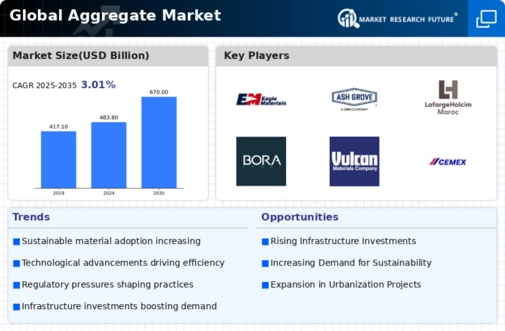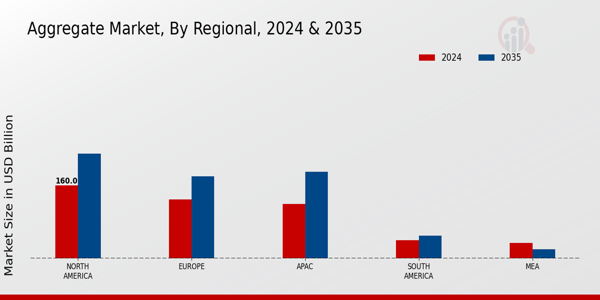Urbanization Trends
Rapid urbanization is a significant driver of the Global Global Aggregate Market Industry, as more people migrate to urban areas, increasing the demand for housing and infrastructure. This demographic shift necessitates vast quantities of aggregates for construction purposes, from residential buildings to commercial complexes. As cities expand, the need for roads, bridges, and public facilities becomes paramount, further fueling aggregate consumption. The ongoing urbanization trends in developing regions are expected to sustain market growth, contributing to the overall market value projected to reach 670 USD Billion by 2035. This phenomenon underscores the critical role aggregates play in shaping modern urban landscapes.
Regulatory Frameworks
The Global Global Aggregate Market Industry is influenced by evolving regulatory frameworks that govern construction practices and environmental standards. Stricter regulations regarding land use, environmental protection, and resource extraction are prompting industry stakeholders to adapt their operations. Compliance with these regulations often necessitates the use of higher-quality aggregates and sustainable practices, which may drive up demand. As governments worldwide implement policies aimed at promoting sustainable development, the aggregate industry is likely to experience shifts in production and consumption patterns. This regulatory landscape could significantly impact market dynamics, potentially leading to increased investment in sustainable aggregate solutions.
Infrastructure Development
The Global Global Aggregate Market Industry is experiencing a surge in demand driven by extensive infrastructure development projects worldwide. Governments are investing heavily in transportation, energy, and urban development, which necessitates a substantial supply of aggregates. For instance, the global market is projected to reach 483.8 USD Billion in 2024, reflecting the critical role aggregates play in construction. This trend is particularly pronounced in emerging economies, where urbanization is accelerating. As nations strive to improve their infrastructure, the demand for aggregates is expected to rise, thereby propelling the market forward.
Technological Advancements
Technological innovations are reshaping the Global Global Aggregate Market Industry, enhancing efficiency and productivity in aggregate production and transportation. The adoption of automation, artificial intelligence, and advanced machinery is streamlining operations, reducing costs, and improving quality. These advancements may lead to increased competitiveness among industry players, as they can optimize resource utilization and minimize waste. Furthermore, the integration of technology in logistics and supply chain management is likely to facilitate timely delivery and reduce lead times, thereby meeting the growing demand for aggregates in construction projects. This evolution could support the anticipated CAGR of 3.0% from 2025 to 2035.
Market Trends and Projections
Sustainable Construction Practices
Sustainability is becoming a cornerstone of the Global Global Aggregate Market Industry, as stakeholders increasingly prioritize eco-friendly construction methods. The shift towards sustainable practices includes the use of recycled aggregates and low-carbon materials, which are gaining traction in various regions. This trend is likely to enhance market growth as regulations tighten and consumers demand greener solutions. The industry's adaptation to sustainable practices not only meets regulatory requirements but also appeals to environmentally conscious consumers, potentially leading to a more robust market presence. The focus on sustainability may also contribute to the projected market growth to 670 USD Billion by 2035.













